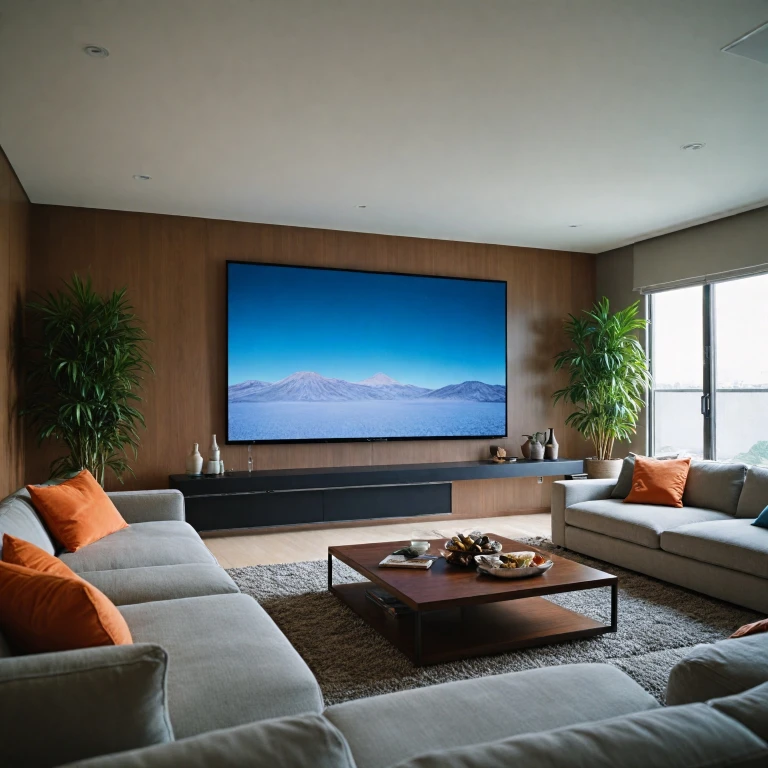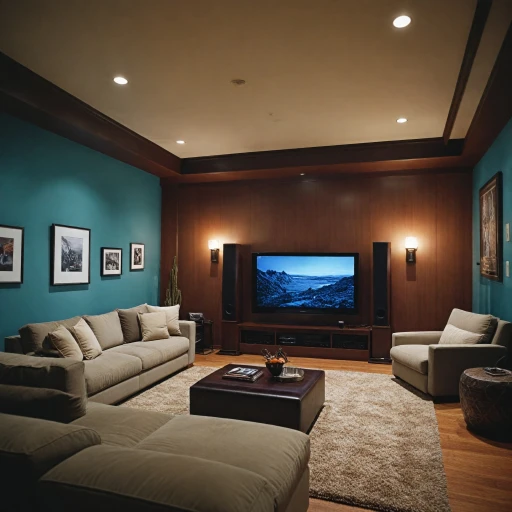Understanding Ultra Short Throw Technology
Get Closer and Still See the Bigger Picture
Understanding the intricacies of ultra short throw technology is the first step towards enhancing your viewing experience. Unlike conventional projectors, an ultra short throw projector allows you to place it mere inches from the screen, significantly minimizing any shadow interference. This innovative design is appealing for those looking to maximize space without compromising on image quality. One enticing feature of these projectors is their ability to produce large images even in small spaces. An ultra short throw projector can deliver stunning images from a relatively close range, offering the convenience of a compact setup. The technology relies on specially designed optics to ensure that images are sharp and distortion-free, no matter how near the projector is to the screen. When combined with the appropriate screen materials, these units can effectively combat ambient light distractions. Technologies like ambient light rejecting (ALR) screens complement UST projectors by absorbing excess light and increasing the contrast for a more vivid picture. This synergy between projector and screen makes the viewing experience richer without having to spend a fortune on an extensive room redesign. In essence, ultra short throw projectors are ideal for creating a home theater experience without the constraints of large mounts and extensive cables. As you dive deeper, you'll discover more benefits when selecting the right screen, setting up your room, and choosing state-of-the-art features for an unparalleled cinematic atmosphere. Embrace the possibilities and explore more on how these advancements can transform your home entertainment.Benefits of an Ultra Short Throw Projector Screen
Reaping the Advantages
Investing in an ultra short throw projector screen can transform your home viewing experience. Unlike traditional projector screens, these advanced screens are designed to work with ultra short throw projectors, allowing you to enjoy a stunning display even in compact spaces.
One of the primary advantages is the ability to place the projector just inches away from the screen. This eliminates the need for extensive setup space, making it an excellent choice for small rooms or areas where space is a premium. Additionally, the screen's ultra short throw technology minimizes shadows and interruptions, resulting in a seamless viewing experience.
ALR (ambient light rejecting) screens are another game-changer. They enhance contrast and image brightness significantly, even in rooms with considerable ambient light. This is particularly advantageous for daytime viewing or in spaces where controlling ambient light is challenging. Moreover, the improved brightness means colors remain vivid and clear, enhancing the overall picture quality.
The ultra short throw projector screens also offer versatile installation options. Whether you're considering a floor rising model or a fixed frame design, there's a solution that caters to your specific setup. The materials used, such as CLR (ceiling light rejecting), can further improve the clarity and intensity of the projected image, making movie nights truly cinematic.
Furthermore, ultra short throw projector screens generally come in various sizes to meet different needs, ranging from a compact 80-inch to an expansive 120-inch setup. This ensures there's an option for every budget and room configuration, offering great flexibility.
Choosing the Right Screen Material
Selecting the Ideal Surface for Your UST Projector
When investing in an ultra short throw (UST) projector screen, one of the most critical decisions involves selecting the proper screen material. The choice affects the quality of the projection and how it reacts to ambient light, ensuring an optimal viewing experience.- Screen Gain: One of the first factors to consider is the gain, which refers to the screen's ability to reflect light. Higher gain screens amplify projection light, making them suitable for environments with some ambient light. For UST projectors, a gain of around 0.6 to 1.0 is typically ideal to prevent hot spotting and to maintain color accuracy under various lighting conditions.
- Ambient Light Rejecting (ALR) Screens: To combat the interference of ambient light, an ALR screen is often recommended. These screens are designed specifically to reflect projector light while rejecting ambient light from different angles. This feature helps maintain vivid colors and clear images, crucial for UST projectors placed in well-lit rooms.
- Fixed Frame and Floor Rising Options: Depending on your room setup, you can choose between fixed frame screens or more portable floor rising projector screens, like the ones offered by brands such as Elite Screens and Vividstorm. Fixed frame screens provide a tensioned surface that stays flat, ideal for a permanent home theater setup. In contrast, floor rising options are convenient for multipurpose rooms where permanence isn’t ideal.
- Material Choice for Best Visuals: The screen material itself impacts the projection quality. ALR materials, CLR (Ceiling Light Rejecting), and specialized ambient projection materials are exemplary for short throw projectors. Brands focus on screen materials that enhance clarity and contrast for the most immersive projection experience.
Considerations for Room Setup
Optimizing Your Space for Ideal Projection
An ultra short throw projector screen offers incredible benefits, but to maximize its potential, proper room setup is crucial. When setting up, consider three main elements: placement, ambient light control, and screen size.
- Placement and Distance: Unlike traditional projectors, UST projectors can sit mere inches from the screen, allowing for an unobtrusive setup. Ensure that your projector is positioned correctly to avoid distortion and achieve the desired image quality.
- Control Ambient Light: One of the key challenges is controlling ambient light. Understand that even the best screens can struggle with excessive light. Investing in black-out curtains or blinds can help, but light rejecting screens (also known as ALR screens) are designed to combat this issue and maintain picture quality by rejecting ambient light. Consider the Spectra and CLR options for better performance in bright environments.
- Screen Size and Material: Choose your screen size based on room dimensions and seating arrangement. Fixed frame screens and floor-rising varieties are popular options for different aesthetic preferences. Materials like gain and elite screens are favorable for their ability to amplify projection quality, enhancing both clarity and brightness.
Setting up a UST projector screen requires careful consideration of these factors to create the best viewing environment. Balance the aesthetics with functionality, ensuring your setup supports both excellent picture quality and immersive experiences.
Top Features to Look For
Key Features to Consider
When selecting an ultra short throw projector screen, several features can significantly enhance your viewing experience. Here are some essential aspects to keep in mind:
- Screen Material: The material of the screen plays a crucial role in image quality. Look for ALR (ambient light rejecting) screens, which are designed to improve contrast and color accuracy in rooms with ambient light. Materials like CLR (ceiling light rejecting) are also beneficial for maintaining image integrity.
- Gain: This refers to the screen's ability to reflect light. A gain of 1.0 is standard, but if you have a bright room, consider a higher gain to enhance brightness. However, be cautious, as too high a gain can lead to hot spots.
- Screen Size: The size of the screen should match the room's dimensions and your projector's capabilities. Common sizes range from 100 to 120 inches, but ensure it fits your space and viewing distance.
- Frame Type: Fixed frame screens offer a permanent setup with tensioned material for a flat surface, while floor rising screens provide flexibility and easy storage.
- Compatibility with UST Projectors: Ensure the screen is compatible with ultra short throw projectors. Not all screens are designed for the unique projection angle and distance of UST projectors.
- Price and Brand: Consider the unit price and brand reputation. Brands like Elite Screens and Vividstorm are known for quality and reliability in the projector screen market.
Remember, the right features can transform your home theater setup, providing a cinematic experience even in challenging lighting conditions.
Maintenance and Care Tips
Keeping Your Ultra Short Throw Projector Screen in Top Condition
Maintaining your ultra short throw projector screen is crucial for ensuring optimal performance and longevity. Here are some practical tips to help you care for your screen and projector:
- Regular Cleaning: Dust and dirt can accumulate on your projector screen, affecting image quality. Use a soft, lint-free cloth to gently wipe the screen. For stubborn spots, a mild soap solution can be used, but ensure it's completely dry before use.
- Proper Handling: When adjusting or moving your screen, handle it with care. Fixed frame screens, in particular, should be moved by holding the frame to avoid stretching or damaging the screen material.
- Ambient Light Control: To maintain the best image quality, control the ambient light in your room. ALR screens are designed to reject ambient light, but minimizing light exposure will enhance the performance of your ultra short throw projector.
- Check the Projector: Regularly inspect your UST projector for dust and debris. Clean the lens with a microfiber cloth to ensure a clear projection. Keeping the projector's ventilation free from obstructions will also prevent overheating.
- Screen Material Care: Different screen materials, like CLR or Spectra, may have specific care instructions. Refer to the manufacturer’s guidelines to ensure you’re using the right cleaning products and techniques.
- Storage Tips: If you have a floor rising screen or a portable unit, store it in a dry, cool place to prevent any damage from moisture or heat. Ensure the screen is retracted and secured properly when not in use.
By following these maintenance tips, you can enjoy vivid images and a seamless viewing experience with your ultra short throw projector screen for years to come.





